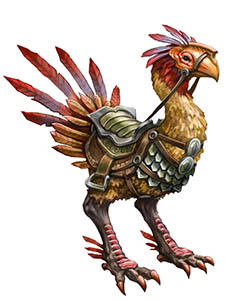Archived: Rideable Creatures
From ThornsWiki
Contents
Horse (Anaxas, Mugroba, Hox, Hesse, Bastia, Gior)
Horses are wild as well as tamed, and can be broken. They are used for riding, pulling carriages and farmwork. They are not generally ridden by the galdori, but they do employ horses as beasts of burden, generally preferring them to kenser.
Moa (Anaxas, Mugroba, Hox, Hesse, Bastia, Gior)
Moa are members of the bird family, and are preferred to horses overall because of their speed and beauty. Agile and intelligent, moa are long-living as well as loyal. Many galdori consider their moa to be part of the family, and give them names. They are flightless and their legs are heavy and strong. Their even gait makes them ideal for riding.
Moa plumage is a soft array of subtle color, with tones ranging from a deep red to golden, black to rich brown. Their tails are sometimes allowed to grow and fall to just above the ground, but often they are clipped.
Domesticated moa are very different from feral moa, which are slightly smaller. Feral moa are rarely seen in Anaxas anymore.
Kenser (Anaxas, Hesse, Bastia, Gior)
The primary beast of burden for pulling wick carts. Kensers look like horses, but have shorter noses, long ears, and stronger, more muscular legs. They have short, dark fur, with tawny spots around the hindquarters and shoulders; they have no mane. Their hooves, which are larger than those of horses, are cloven, and leave distinctive tracks. Their tails are clipped short. Often, they are fitted with goggles to protect them from sand, dust or other frequent irritants of the road.
They are docile and friendly beasts and very popular among children. They have a low and melodious call, which resembles that of a dove.
Chrove (pl. chroven) (Hox, Anaxas, Bastia)
Large, scaled and monstrous beasts ridden by the Seventen. They are chosen for their swiftness as well as their intimidating features. The chrove is technically a member of the genus Panthera, but its skin is furless, hardened into a blackened texture resembling scales. Their legs are short, but powerful; the head sits low on the body, near to the ground, where the chrove sniffs out its prey. Their ears, too, have been subject to a sort of evolutionary protection, nestled closely to a pair of curled horns.
A kind of hardened shell covers the majority of the chrove's spinal column; the Seventen outfit their chroven with armor as well as a saddle and a harness. Their claws, which are quite big already, are fitted with steel reinforcements.
Chroven have large, thick tails that serve as a fifth limb, a battering ram, and, sometimes, a balance. Their weak spot is their relatively soft underbelly.
Suba (pl. subae) (Hesse)
Subae are a type of massive boar, normally wild and dangerous, native to Hesse's vast grasslands. They are caught at a young age and domesticated, but breeding them in captivity leads to weak and slower subae. This makes owning a suba the mark of the very rich or the very brave, and many of the very rich wish to give the impression that they are the latter rather than the former.
Young subae are called "farrows", and are raised to be rideable mounts. Though in the wild they are very aggressive and assertive, if trained properly subae are very obedient and intelligent animals, more so than a horse or moa. A well-trained suba is the mark of great expense and care.
In appearance the suba is very like the wild boar, save a few differences; most noticeably, they are a pleasing golden color with brown grass-like stripes. They are much larger than most wild boars, and have longer legs, sometimes reaching a height of eleven hands at the withers and weighing over a ton. Their tusks can grow to be quite large, over three feet long and several inches thick. Sometimes owners adorn the tusks with metal bands or piercings; usually, owners of domesticated subae in cities saw off their tusks, file down the stumps, and display the tusks over their mantle-pieces as trophies to show that they properly trained one.


